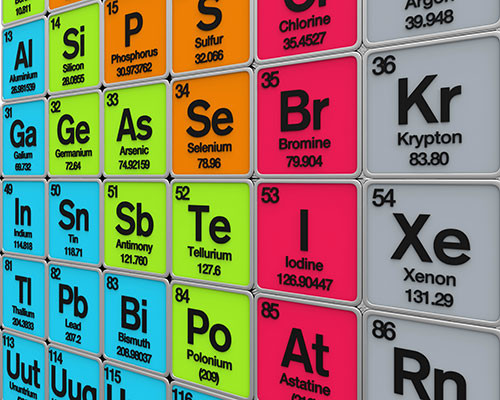
(Courtesy: Shutterstock/Nerthuz)
By Michael Banks
It will soon be time to get the Tipp-Ex out on your copy of the periodic table.
That is because the International Union of Pure and Applied Chemistry (IUPAC) and the International Union of Pure and Applied Physics (IUPAP) have announced the discovery of four new elements: 113, 115, 117 and 118 – completing the table’s seventh row.
The two unions jointly declared that element 113, currently called ununtrium, was discovered by researchers at the RIKEN lab in Japan in work published between 2004 and 2011.
They also announced that between 2010 and 2013, researchers from three labs – the Joint Institute for Nuclear Research in Dubna, Russia, as well as the Lawrence Livermore National Laboratory and Oak Ridge National Laboratory, both in the US – discovered elements 115 and 117, which are currently called ununpentium and ununseptium, respectively.
As for element 118, IUPAC and IUPAP credit a collaboration between Livermore and Dubna with discovering ununoctium in 2006.
The labs involved in the discoveries will now be able to propose permanent names and symbol for each element, which will be checked by IUPAC for consistency, historic use as well as how well the name translates into other languages. Once it passes that stage, the name and symbol will then undergo public consultation for five months before a final decision is made by IUPAC’s council.
So physicsworld.com readers – what are your suggestions for naming elements 113, 115, 117 and 118?
Well, that’s easy!
Oneonethreeium
Oneonefiveium
Oneonesevenium
Oneoneeightium
The names will come from the Dubna and the RIKEN teams that discovered these super-heavy elements (SHE). There are now 12 SHE’s going from Z= 107 to 118 found in the so-called “cold fusion” and the “warm fusion” in the Darmstad (Germany), the Dubna (Russia) and RIKEN(Japan) labs. It is a stupendous achievement, indeed!
How about?
Corbynium
Abbottonium
Mcdonnellanium
Marxonium
Well, there is a very strongly motivated proposal for one of them:
https://www.change.org/p/support-lemmy-tribute-name-newly-discovered-heavy-metal-lemmium
I WOULD PEFER MORE CLASSIC COMPOSERS:
115. BACHIUM, SYMBOL Bc
116: MOZARTIUM: SYMBOL Mz
118:BEETHOVENIUM. SYMBOL Bh
and the 113, I will leave to the Japanese Scientists to baptise
Good news that the 7p elements are about to be named.
There is already a Lawrencium at 103 so there could now be a Livermorium (Lv).
Dubnium (Db) has already been credited at 105, so there could now be an Oakium (Ok) to more easily remember 118 and the completion of period 7.
I recently emailed RIKEN to offer my congrats and to suggest 3 possible names: Rikenium, Nipponium, Nihonium.